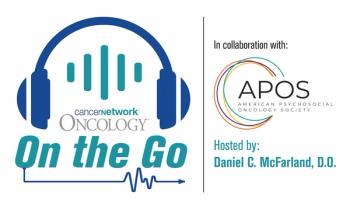
Oncology NEWS International
- Oncology NEWS International Vol 11 No 12
- Volume 11
- Issue 12
Advances in the Management of Lymphoma
The past year hasseen a number of excitingadvances in the managementof patients withhematologic malignancies.The principal developmentshave beenthose focused on the conceptof targeted therapy.Though this conceptis not new, continuedevolution in therapeuticstrategies and advancesin knowledge of the biologyof various cellulartargets more than everare bringing about thepotential for new therapieswith additive or synergisticpotential and minimal additional toxicity.
The past year hasseen a number of excitingadvances in the managementof patients withhematologic malignancies.The principal developmentshave beenthose focused on the conceptof targeted therapy.Though this conceptis not new, continuedevolution in therapeuticstrategies and advancesin knowledge of the biologyof various cellulartargets more than everare bringing about thepotential for new therapieswith additive or synergisticpotential and minimal additional toxicity.In this special supplement to Oncology News International(ONI ), we present a compilation of reports onhematologic malignancies published in ONI over thepast year. In this commentary we review some of theimportant data and news regarding the lymphomas.The original reports from ONI follow on the subsequentpages. Dr. Michael Keating presents a commentary onhappenings in leukemia on page 17, and again this isfollowed by highlights from ONI 2002.CHOP/Rituximab Superior to CHOP Alone
The results of the GELA trial randomizing patientswith diffuse large B-cell lymphoma aged 60 years orolder to cyclophosphamide, doxorubicin, vincristine,prednisone (CHOP) vs CHOP/rituximab (Rituxan) areparticularly exciting and encouraging (see page 4 formore on the Groupe d'Etude des Lymphomes de l'Adulte[GELA] trial). The first peer-reviewed manuscript forstudy was published in the New England Journal ofMedicine in January 2002 (346:235-242, 2002).This study provides level I evidence that the addition ofrituximab is superior to CHOP alone in this patientgroup. Whether or not these are the best results that canbe achieved with this combination or particular strategyremains to be seen. An Eastern Cooperative OncologyGroup (ECOG) study (E4494) with a similar design buta different administration schedule for rituximab containeda second randomization to maintenance rituximabvs no further rituximab. This trial has now completedaccrual, and is awaiting preliminary results.The data published by Czuczman et al using thecombination of CHOP/rituximab in patients with indolentnon-Hodgkin's lymphoma (NHL) also lendssome insight into the potential benefit of this combinationin the setting of indolent NHL. In this phase IIstudy CHOP was administered at standard dosesalong with six infusions of rituximab at a dose of 375mg/m2. The high complete response rate (67% inevaluable patients) and duration of progression-freesurvival (median not reached at 5.4 years follow-up)is superior to that expected with CHOP alone, althoughthe phase II nature of the design makes itdifficult to determine whether or not other factors suchas inadvertent selection bias might have had anyinfluence on the results. The conversion of manypatients to polymerase chain reaction (PCR) negativityfor bcl-2 suggests clearance of minimal residualdisease with this regimen. Again, a relevant questionparticularly in this setting would be the issue ofmaintenance therapy.Maintenance Therapy Offers Benefit
A study presented by Ghielmini et al at the EighthInternational Conference on Malignant Lymphoma (ICML)in Lugano, Switzerland treated newly diagnosed/relapsedor resistant patients with indolent NHL withrituximab 375 mg/m2 weekly for 4 weeks. Patients withat least stable disease were randomized to furtherrituximab every 2 months for 8 months vs observation,and experienced a longer event-free survival.This type of preliminary data should revitalizeinterest in further trials looking at the concept ofmaintenance therapy, particularly for indolent lymphomas.Monoclonal antibody therapy appears tobe well tolerated and efficacious when used repeatedly,and most physicians would agree in conceptthat indolent lymphomas are a good model in whichto explore the maintenance concept.New Standards for Aggressive NHL?
Two parallel-randomized trials from Germany forpatients with aggressive lymphomas have led to provocativeresults (see page 5). Each study had anidentical 2x2 factorial design (looking at the effect ofvarying the treatment interval for CHOP between 14and 21 days and the effect of adding etoposide toCHOP [CHOEP]). The first study treated patients 18to 60 years of age and concluded that in this patientpopulation complete response rates and time to treatmentfailure were superior for the CHOEP regimenswithout added nonhematologic toxicity, while varyingtreatment intervals had no effect on outcome. Thesecond study treated patients between 61 and 75years of age and concluded that in this patient population,CHOP delivered at 14-day intervals was superiorto CHOP delivered at 21-day intervals (time totreatment failure and overall survival), whereas theaddition of etoposide was of no detectable benefit.With identical designs leading to such disparateresults based on age only and the current trendtoward the use of rituximab in conjunction with CHOPfor aggressive NHL, these studies would probablyrequire replication and/or longer follow-up for mostclinicians to consider a change in practice.NCCN Guidelines for NHL Updated
The most recent version of the National ComprehensiveCancer Network (NCCN) guidelines for thetreatment of early Hodgkin's disease have been alteredbased on recent results from European randomizedtrials (see page 7). Present recommendationsare following the pendulum in its path back towardcombined-modality therapy in an attempt to minimizelong-term toxicity resulting from more aggressive useof either single modality. Consideration of staginglaparotomy has been removed from the guidelines,because combined-modality therapy is recommendedas preferred front-line therapy for virtually allpatients with early-stage disease. Though certain situationsmay arise where radiation therapy alone isacceptable, it is unlikely to be the preferred therapyin any setting.The guidelines appropriately continue to stress theimportance of participation in clinical trials for patientswith advanced disease, such as the ongoing UScooperative group randomized trial of ABVD (doxorubicin,bleomycin, vinblastine, and dacarbazine) vsStanford V (doxorubicin, vinblastine, mechlorethamine,vincristine, bleomycin, etoposide, and prednisone)for newly diagnosed patients with bulky or advancedstage disease.Zevalin Approved in Refractory NHL
The approval of ibritumomab tiuxetan (Zevalin) forpatients with relapsed/refractory indolent or transformedindolent NHL marks the first ever radiolabeledantibody approved for use in cancer treatment (seepage 10). The antibody is labeled with indium-111 forinitial imaging/biodistribution, and is labeled withyttrium-90 for the therapeutic infusion. The addition ofyttrium-90 to the anti-CD20 antibody produces significantmyelosuppression in approximately half of treatedpatients. However, life-threatening complicationssuch as bleeding and infection are extremely rare, andcan be minimized by careful monitoring (and whereappropriate treatment) of cytopenias until clear resolutionoccurs.When compared with rituximab in a randomizedtrial, ibritumomab demonstrated a higher responserate but no clear advantage in time to progressionwas seen. Given this observation, and given thatpatients even refractory to rituximab can respond toibritumomab, it seems most likely that ibritumomabwill find its way into the clinic as a salvage therapyfor patients who have had prior rituximab. It shouldbe remembered that the safety profile for ibritumomabis defined only in patients with < 25% bone marrowinvolvement by lymphoma and a platelet count of atleast 100,000/μL.Radiotherapy for NHL Defined
Recent data have perhaps helped further definethe role of radiotherapy in patients with early-stageNHL (see page 10). A trial by Miller and colleaguesfirst reported in the New England Journal of Medicinein 1998 randomized patients with early-stage NHL tothree cycles of CHOP/involved-field radiation vs eightcycles of CHOP. This trial was initially reported asshowing a small but statistically significant advantagefor patients randomized to the combined-modalitytherapy arm. With a median follow-up of more than8 years, updated results continue to show an advantagefor patients receiving combined-modality therapythrough 7 to 9 years post-treatment. However theKaplan-Meier estimates now overlap at 7 years forfailure-free survival, and 9 years for overall survival,suggesting the benefit of combined-modality therapymay not carry over past this point in time.One possible conclusion from this study is thatpatients with early-stage disease actually require moreor different initial systemic therapy than three cycles ofCHOP. The randomized ECOG study for patients withuntreated bulky or extranodal stage I or stage II aggressiveNHL demonstrated a reduction in relapserates for patients who received involved-field radiotherapyin first complete remission, but intent-to-treatdata were unable to demonstrate a survival advantagewith this approach. However, of note, involved-fieldradiotherapy delivered to sites of residual disease forpatients in first partial remission after CHOP converted28% of those patients to complete response.Autologous/Nonmyeloablative
SCT Approach Promising
The notion of using autologous stem cell transplants(ASCT) as initial therapy, followed byconsolidative nonmyeloablative stem cell transplantation(NST) is receiving considerable attention, particularlyfor chemosensitive indolent diseases such asfollicular lymphoma and multiple myeloma. A pilotstudy by Maloney et al treated 41 patients withmyeloma with melphalan/ASCT followed by NSTusing total body irradiation/unmodified allogeneicstem cells from HLA-identical siblings (see page 15).The majority of patients did not require hospitalization,and all patients successfully engrafted with amedian of 90% donor cells by day 28 post-NST.Treatment-related mortality was 12% at 1 year, andprogression-free survival 85% at a median of 328days post-NST. Though graft-vs-host disease was seenin nearly 50% of patients, this two-phase approachappears to be much less toxic than full allografting,and is one of the randomized treatment arms in astudy being conducted by the Bone Marrow TransplantClinical Trials Network.What Can We Expect in 2003?
The year 2003 will see a continuing evolution inour knowledge of the roles of various targeted therapies.Expect to see a continued emphasis on determiningthe role of monoclonal antibody therapy in anumber of settings such as early-stage diffuse large Bcelllymphoma, with other chemotherapy combinations,and in the setting of autologous stem celltransplantation. Also look for studies examining thepossible role of multiple antibody combinations withor without cytokines or other cytotoxic therapy. Anexample of this is the National Cancer Institute trial ofapolizumab and rituximab in the setting of relapsedlymphomas and chronic lymphocytic leukemia.The development of agents like rituximab andibritumomab has led to a sometimes confusing myriadof phase II data over the past few years. We mustnot forget that the principal role of phase II studies isto identify therapies with acceptable toxicity andreasonable evidence of efficacy, but that the goldstandard remains the testing of these new therapiesagainst existing standard therapies in large welldesignedrandomized phase III trials.
Articles in this issue
about 23 years ago
Stereotactic Radiosurgery Benefits Brain Met Patientsabout 23 years ago
Cancer Risk From Tainted Polio Vaccine Undetermined: IOM Reportabout 23 years ago
Tailored Messages Motivate Women to Get Mammogramsabout 23 years ago
Chemo/Rituximab Is Effective as First-Line CLL Therapyabout 23 years ago
Preoperative Capecitabine/RT Downstages Rectal Cancerabout 23 years ago
Intraoperative Lymphatic Mapping Enhances Cancer Stagingabout 23 years ago
Rituximab Ups Survival in Aggressive and Indolent NHLabout 23 years ago
Genzyme Molecular Oncology Begins Kidney Cancer Vaccine Trialabout 23 years ago
Lower Breast Cancer Survival in Hispanics: New Mexico StudyNewsletter
Stay up to date on recent advances in the multidisciplinary approach to cancer.





















































































